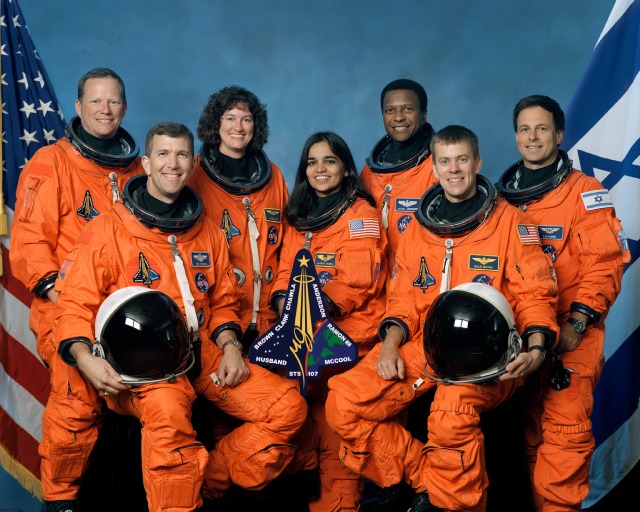WHEN WILL THE SHUTTLES FLY AGAIN? INVESTIGATION FINAL REPORT
Residents in southwestern and southcentral states — from California through Arizona, New Mexico, Texas and Louisiana — reported seeing and feeling an explosion. Columbia, the oldest shuttle in the fleet of four, was to have landed at 9:16 a.m. EST at Kennedy Space Center.
Television broadcast video of the shuttle streaking at 12,500 miles per hour across the sky 40 miles above Dallas showed multiple vapor trails as the spacecraft appeared to break apart. Thousands of small pieces of debris were strewn across a wide area from eastern Texas into Louisiana. Nacogdoches, Texas, police found pieces of debris inside the city limits and in the surrounding county.
The crew. Aboard the shuttle during the 16-day flight had been commander Rick D. Husband, 45; pilot William C. McCool, 40; payload commander Michael P. Anderson, 42; mission specialists David M. Brown, 46; Kalpana Chawla 41; and Laurel Clark, 41; and Israel's first astronaut, payload specialist Ilan Ramon, 47. Ramon had been a national hero in Israel for taking part in the 1981 bombing of a nuclear reactor in Iraq.
David Brown, Laurel Clark, William McCool and Ilan Ramon were on their first spaceflight. Michael Anderson, Kalpana Chawla and Rick Husband were making their second flights.
[See astronauts' photos and biographies below]
What NASA said at the time. NASA Entry Flight Director Leroy Cain declared a contingency for the shuttle Columbia at around 9:14 a.m. EST as the shuttle and its seven astronauts were headed toward a landing at the Kennedy Space Center. Columbia fired its braking rockets at 8:16 a.m. EST and entered the Earth's atmosphere with all of its systems functioning normally for a landing at the Florida spaceport at 9:16 a.m. Communications were lost with Columbia around 9 a.m. EST as the orbiter streaked over Texas. NASA began to use all of its tracking facilities to look for Columbia, when communications had not restored by the time the shuttle had been scheduled to land. Contingency procedures were in effect as landing support officials were dispatched east of the Dallas-Forth Worth area to search for debris.
NASA warned residents under the shuttle's footprint, "If you find debris, please do not touch it, and if you have photos or videos that you think will be helpful, please contact your local police authorities."
Three months later, NASA reported on April 26 that some 70,000 pieces of Columbia had been collected from the ground. That amounted to about about 40 percent of the weight of the shuttle. The pieces were shipped to Kennedy Space Center in Florida for use by accident investigators.
[NASA's investigation site]
Six monnths after the accident, on August 26, the Columbia Accident Investigation Board released its findings.
[Columbia Accident Investigation Board site]
 The central element of the STS-107 mission patch is the microgravity symbol, µg, flowing into the rays of the astronaut symbol [click to enlarge] |
Science Not All Lost.
top of this page
The STS-107 mission was NASA's most scientifically ambitious spaceflight in years. Columbia carried more than 80 experiments — so many that the astronauts had to form two 12-hour shifts so they could carry on their experimentation around the clock.
Most of the research focused on saving lives on Earth. For instance, they studied the growth of prostate cancer tissue in hopes of finding a treatment.
Another experiment on combustion created the weakest flame ever lit in a laboratory — about 1/200th the flame of a match. The astronauts found that weaker flames create less soot. That's important because soot accounts for about 60,000 premature deaths in the United States.
Much of the science data gathered during Columbia's 16 days in orbit was lost with the shuttle. However, NASA has been able to harvest some of the results of the experiments conducted by the astronauts because they beamed their data down by radio while still in space. Other experiments and results were recovered amidst the debris on the ground.
Worms found alive. Surprisingly, hundreds of worms from one of the science experiments were found alive amidst the debris in Texas. The worms were the only live experiments found and identified from Columbia's 60 scientific investigations. Some dead moss cells were found with the worms.
The worms, known as C. elegans, and the dead moss cells had been in a nine-pound locker on the shuttle mid-deck. Six canisters, each with eight petri dishes, contained the worms. Seven of eight aluminum canisters containing the moss were recovered.
About the size of a pencil point, the worms have a life cycle of 7-10 days. Those found were four to five generations removed from the original worms sent to space in Columbia to test a synthetic nutrient solution.
C. elegans worms are primitive organisms that share numerous biological characteristics with humans. C. elegans worms have two sexes — males and hermaphrodites. The hermaphrodites are females that produce sperm. The hermaphrodites fertilize themselves for their first 300 eggs, but then accept sperm from male worms. That allows the species to produce more offspring. In 1999, C. elegans had become the first multicellular organism to have its genome completely the sequenced.
Moss preserved. The type of moss flown on Columbia is known as Ceratodon. It was used to study how gravity affects cell organization. The moss was sprayed during the flight with a chemical that destroyed its protein fiber. Then formaldehyde was used to preserve the dead moss.
Others recovered. A 6.5-inch wide, 11-inch long aluminum device found in the shuttle debris in Nacogdoches, Texas, may yield science experiment data.
Other experiments and results recovered amidst the debris were:
- a "tin crystal" experiment sent aloft by Florida middle school students who raised $5,000 with a spaghetti dinner and donated pennies to pay for their space aboard the shuttle,
- a biofilm "peace experiment" by an Israeli medical student and a Palestinian biology student who wanted to know if organisms could travel between planets on meteorites,
- a protein crystal experiment for developing a drug to fight cancer,
- a prep school study of the effect of zero-gravity on bacteria,
- a Southwest Texas State University experiment on slime mold.
The Oldest Shuttle.
top of this page
Columbia was the oldest shuttle in the NASA fleet. It first was launched in 1981. The fatal flight was its 28th mission.
Columbia had been taken out of service to receive 50 modifications in 1991-1992. It was refurbished again in 1994-1995. Then Columbia received 100 more modifications during an extensive 17-month overhaul from September 1999 to February 2001. It returned to space in March 2002.
After a flawless and uneventful countdown on Jan. 16, 2003, the shuttle had been launched at 10:39 a.m. EST upward through a cloud-washed blue sky above Launch Pad 39A at Kennedy Space Center. It was the first U.S. shuttle mission of 2003 and the 113th flight overall in NASA's space shuttle program.
Columbia flew a 16-day research mission during which astronauts used a major package of science experiments known as Fast Reaction Experiments Enabling Science, Technology, Applications and Research (FREESTAR) in the SPACEHAB (SHI Research Double Module or SHI/RDM). Experiments in the module ranged from material sciences to life sciences.
| Columbia's Flight History |
|---|
|
|
|||||||||||||||||||||||||||||||||||||||||||||||||||||||||||||||||||||||||||||||||||||||||||||||||
Columbia, the name. Columbia is a name honoring the famous explorer Christopher Columbus. The name frequently is used as the feminine personification of the United States.
The space shuttle Columbia was named after an 18th century sloop Columbia that sailed out of Boston, Massachusetts, captained by American pilot Robert Gray. On May 11, 1792, Captain Gray and his crew maneuvered the ship through tight inland waters past a dangerous sandbar at the mouth of a river extending a thousand miles through what today is southeastern British Columbia, Canada, and the Washington-Oregon border region. The crew explored British Columbia and what we now call the states of Washington and Oregon. Later, that major river would be named Columbia after the sloop.
NASA referred to the shuttle Columbia as OV-102 for Orbiter Vehicle-102. The orbiter weighed 178,000 lbs. including its main engines.
top of this page
|
The astronauts:
[click image to enlarge NASA photo] [click name to read NASA biography] |
||
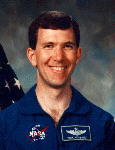 Rick D. Husband Commander The U.S. Air Force colonel and mechanical engineer, 45, was returning from his second space trip. He had piloted a shuttle in 1999 to the first docking with the International Space Station. |
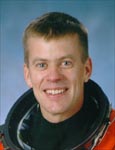 William C. McCool Pilot The U.S. Navy commander, 40, and former test pilot was returning from his first space trip. He had been responsible for maneuvering the shuttle during science experiments. |
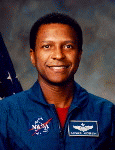 Michael P. Anderson Payload Commander The U.S. Air Force lieutenant colonel and physicist, 42, also had flown to space in a 1998 shuttle flight that docked with the Russian space station Mir. On STS-107, he had been responsible for science. |
 David M. Brown MissionSpecialist The U.S. Navy captain, aviator and flight surgeon, 46, was returning from his first space flight. He had been working on biological science experiments. |
 Kalpana Chawla Mission Specialist Returning from her second space flight, Chawla, 41, had flown more than 375 hours in space. She had operated the shuttles robotic arm on a flight in 1997. |
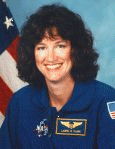 Laurel Clark Mission Specialist The U.S. Navy commander and flight surgeon, 41, was returning from her first space flight during which she had conducted biological experiments. |
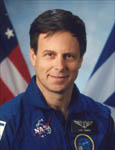 Ilan Ramon Payload Specialist Israel's First Astronaut The colonel and Israeli Air Force fighter pilot, 47, was the first Israeli to fly in space. He had seen combat experience in the Yom Kippur War in 1973 and the Lebanon War in 1982. |
||
National Mourning.
top of this page
As the tragedy was occurring, President Bush was at Camp David, Maryland, from where he returned to the White House to speak to the nation via television at 2 p.m. EST.
"This day has brought terrible news and great sadness to our country," he said, declaring however that, "The cause in which they died will continue. Mankind is led into the darkness beyond our world by the inspiration of discovery and the longing to understand. Our journey into space will go on."
Read the words of President George W. Bush (Whitehouse)
"This is indeed a tragic day for the NASA family, for the families of the astronauts who flew on STS-107, and likewise is tragic for the Nation," said NASA Administrator Sean O'Keefe. "We met with the family members of the astronauts who were here at the Kennedy Space Center and are soon to be departing back to the Johnson Space Center in Houston. The President has called and spoken to the family members to express our deepest national regrets. We have assured them that we will begin the process immediately to recover their loved ones and understand the cause of this tragedy."
The astronauts "dedicated their lives to pushing scientific challenges for all of us here on Earth. They dedicated themselves to that objective and did it with a happy heart, willingly and with great enthusiasm," O'Keefe said.
Statement of NASA Administrator Sean O'Keefe (pdf)
The American flag was lowered to half-staff at the Kennedy Space Center countdown clock, the Johnson Space Center near Houston, the White House, the Capitol, and at countless other locations around the nation. A national commission now will try to determine what went wrong.
President Bush told thousands of mourning families and friends attending a memorial service Feb. 4 at Johnson Space Center in Houston that the Columbia astronauts "go in peace for all mankind and all mankind is in their debt...The final days of their own lives were spent looking down upon this Earth, and now, on every continent, in every land they can see, the names of these astronauts are known and remembered," he said.
Remarks of President Bush at the Memorial Service (Whitehouse)
Honoring Those Lost.
top of this page
As shuttle debris was gathered across Texas over the ensuing weeks, the remains of the astronauts also were gathered, in pieces, and identified through DNA analysis:
- Air Force Col. Rick Husband's funeral was in Clear Lake, Texas, on Feb. 5. He then was buried in his hometown of Amarillo, Texas. The high plains city renamed its airport as the Rick Husband Amarillo International Airport.
- The remains of Israeli Air Force Col. Ilan Ramon were buried in Israel on Feb. 11. He was mourned widely in the Jewish community because of its symbols he had carried aboard Columbia. He had taken several Holocaust objects including a Torah used at a Bar Mitzvah ceremony in a concentration camp, and a drawing entitled "Moon Landscape," by 14-year-old Petr Ginz, who died at Auschwitz. Ramon also had kosher food, a kiddush cup, several mezuzahs, and a credit-card sized microfiche of the Bible. Ramon was said to have spoken the words of the fundamental Jewish prayer, the Shema, as Columbia passed over Jerusalem.
- Dr. Kalpana Chawla's remains were cremated and her family held a funeral in India in March. As the first Indian-born woman astronaut, she was a role model for young women in her native country.
- Navy Commander William McCool's funeral service was March 1 at the U.S. Naval Academy in Annapolis, Md. His remains were retuned to his home state of Washington for burial.
- Air Force Lt. Col. Michael Anderson, Columbia's payload commander, was buried in Arlington National Cemetery on March 7. Across the country, Washington's state Transportation Commission honored Anderson by renaming state route 904 for him. The astronaut had considered Spokane his home. The 20-mile highway loops from Cheney to Interstate 90 at exits 257 and 270.
- Navy Commander Laurel Clark was buried at Arlington on March 10, which would have been her 42nd birthday. She had considered Racine, Wisconsin, her hometown. NASA and military officials posthumously awarded Dr. Clark three medals for distinguished service to her country — the Defense Distinguished Service Medal, NASA's Distinguished Service Medal and the NASA Spaceflight Medal.
- Navy Capt. David Brown, was interred on March 12, the last of the Columbia seven to be buried and the 19th astronaut laid to rest at Arlington National Cemetery in Arlington, Virginia, which Brown considered his home town.
Recalling Challenger
Columbia Elementary School. The School Board of the Val Verde Unified School District in California in March named the new Columbia Elementary School in honor of the seven astronauts. The school in Mead Valley, California, will open in August 2004.
Val Verde Unified School District
Seven trees planted. Seven oaks honoring the Columbia crew were planted in the Astronaut Memorial Grove at the Johnson Space Center in Houston. The stand had been started back in 1996 near NASA Road 1 in front of JSC. With a tree planted each time a present or former astronaut dies, the grove had 33 live oaks and shumard red oaks before February 1, 2003.
Arlington memorial. On April 16, President George W. Bush signed the Emergency Wartime Supplemental Appropriations Act, 2003 making it Public Law Number 108-11. The Columbia Orbiter Memorial Act, contained in that act, authorized the Secretary of the Army to spend $500,000 to place a new marker in Arlington National Cemetery near the earlier memorial to the shuttle Challenger crew. NASA was permitted to collect donations over five years for the Columbia Memorial. The space agency also may erect other monuments with private donations.
Black armbands. During their April 26 launch to the International Space Station, crew members Edward Lu and Yuri Malenchenko — ISS Expedition Seven — wore black mourning bands on their arms in memory of the shuttle Columbia crew.
Asteroids named for astronauts. In July 2003, the Minor Planet Center of the International Astronomical Union named these seven asteroids after the lost Columbia astronauts:
- 51823 Rickhusband
- 51824 Mikeanderson
- 51825 Davidbrown
- 51826 Kalpanachawla
- 51827 Laurelclark
- 51828 Ilanramon
- 51829 Williemccool
NASA announcement All asteroid names How naming works
Columbia Survivors.
The Columbia astronauts left behind 13 parents, 6 spouses, 12 children, and 20 brothers and sisters in three countries.
The families of the Columbia crew expressed gratitude for the outpouring of support around the world. Several charitable funds were established on behalf of the families.
Information on the funds
Religious faiths. Columbia's crew represented seven religious beliefs — Michael Anderson, Baptist; Rick Husband, Charismatic; David Brown, Episcopalian; Kalpana Chawla, Hindu; Ilan Ramon, Jewish; William McCool, Roman Catholic; and Laurel Clark, Unitarian.
Investigating the Disaster.
top of this page
The official Columbia Accident Investigation Board (CAIB) includes:
- Admiral Hal Gehman, USN,chair of the board
- Dr. Douglas Osheroff, Nobel Prize laureate in Physics
- Dr. Sally Ride, physicist and former NASA astronaut
- Dr. John Logsdon, George Washington University Space Policy Institute Director
- Rear Admiral Stephen Turcotte, Commander, Naval Safety Center
- Maj. General John Barry, Director, Plans and Programs, Headquarters Air Force Materiel Command
- Major General Kenneth W. Hess, Commander, HQ USAF Chief of Safety
- Dr. James N. Hallock, Chief, Aviation Safety Division, Department of Transportation, Volpe Center
- Steven B. Wallace, Director of Accident Investigation, Federal Aviation Administration
- Brig. General Duane Deal, Commander, 21st Space Wing, USAF
- Scott Hubbard, Director, NASA Ames Research Center
- Roger E. Tetrault, McDermott International (Ret)
- Dr. Sheila Widnall, Massachusetts Institute of Technology (MIT) Professor of Aeronautics and Astronautics and Engineering Systems, and former Secretary of the Air Force.
- Michael J. Bloomfield, an astronaut who has flown three shuttle missions, is a former chief of safety in NASA's Astronaut Office and currently serves as chief astronaut instructor, Ex-Officio Member
- Theron Bradley, Jr., NASA Chief Engineer, Executive Secretary to the board
Falling foam. The board found that 82 seconds into the Columbia launch in January, 2003, the shuttle's left wing was struck by insulating foam falling from the large external fuel tank. Investigators said that opened a hole through which superheated gas penetrated the spacecraft during its re-entry from orbit on February 1. That tore the ship apart and killed the seven astronauts aboard.
NASA somehow will find a way to fix the foam threat from that part of the external tank. Referred to as the bi-pod area, that section of the tank is where the orbiter's nose is attached. If the agency were to eliminate the foam insulation there, heaters would have to be installed to prevent ice from forming.
The investigation board recommended improving photography of launches, using telescopes to photograph shuttles while they are in space, and adding the ability to repair a shuttle while in orbit.
[Columbia Accident Investigation Board site] [NASA's investigation site]
NASA will make all changes mandated by the Columbia Accident Investigation Board as it prepares to send the shuttle fleet back to space.
Watching closely. During the January 2003 launch, one of the launch pad cameras could have captured the best images of the craft's left wing, but it was out of focus. Now the first return-to-space launch will be scheduled for daylight hours to give the high-resolution cameras on the launch pad the best views of problems during launch.
The U.S. National Imagery and Mapping Agency has agreed to use spy satellites to photograph shuttles in orbit on future missions. The photos would be made automatically without a special request from NASA. During the 2003 flight, photos of the three-inch insulating tiles beneath Columbia's left wing might have helped engineers assess the danger before the shuttle started to land.
top of this page
When Will the Shuttle Fleet Return to Space?
Shuttle recovery flights: Index 2005 2006
There were problems. The return-to-flight launch of space shuttle Discovery scheduled for July 13 was scrubbed when a problem appeared in a fuel cutoff sensor inside the external hydrogen fuel tank. That sensor protects the orbiter's main engines by shutting them down if fuel runs low. A new launch time is expected to be announced soon after NASA engineers decide how to fix the problem. The earliest possible flight date would be July 16, 2005. However, NASA might set a later date for the next launch attempt. The current launch window closes July 31. After that, the next window opens September 9.
Chronology of some of the delays in preparations:
- NASA has been redesigning shuttle systems and preparing for flight since the Columbia disaster in February 2003.
- William F. Readdy, associate administrator for space flight, said in August 2003 that the first shuttle to fly again might head to space between in March or April 2004.
- Later, NASA revised the post-accident launch schedule with a first flight, by Atlantis, in September 2004, and a second flight, by Discovery, in November 2004.
- On February 12, 2004, NASA Administrator Sean O'Keefe told the U.S. House of Representatives Committee on Science that there was only a "very low prospect" that the space shuttle fleet would be able to resume flying in 2004. Flights were delayed by the need for more time to develop a shuttle on-orbit inspection system and to reduce the debris shedding from over a larger area of the shuttle external tank during launch. The inspection system would be an instrumented boom extending from the end of the shuttle¹s robot arm for inspecting the underside of a shuttle for damage.
- Later in February 2004, NASA officials said the first return-to-space flight would not occur before March 2005. In the revised plan, the shuttle Discovery would make the first flight and shuttle Atlantis would be on standby for the second flight.
- After four hurricanes affected several NASA centers in Fall 2004, the space agency announced in October that the March-April 2005 launch window was no longer achievable. The next available launch window would open May 14, 2005.
- Then, NASA said on February 18, 2005, it would launch Discovery on May 15, 2005.
- On April 20, NASA said it would launch Discovery on May 22.
- However, on April 29, the space agency said it couldn't make the May date and would launch Discovery on July 13, 2005, or shortly thereafter.
Everything seemed to be ready on July 13 when a fuel tank sensor malfunctioned 2-1/2 hours before the planned launch time. The flight was postponed so engineers could resolve the problem.
- Whenever it occurs, the launch of Discovery would be the first since the Columbia disaster in February 2003.
Space agency officials say they could launch Atlantis as a rescue craft if the Discovery crew had to seek shelter aboard the space station.
If there is no emergency, NASA plans to launch shuttle Atlantis a month or so after the launch of Discovery.
Test flights. The space agency has said the 2005 launches would be test flights of the shuttles. After those are successful, NASA would resume assembly of the International Space Station with a shuttle flight in December.
View the NASA Return to Flight site
The United States, Russia, Europe, Japan and Canada – the five space agencies building the ISS in orbit – said station assembly would be completed by the end of this decade.
Read the NASA press release about the 2004 hurricanes
Read the House Committee on Science press release on Administrator Sean O'Keefe testimony
Rescue shuttle on standby. Whenever a shuttle does fly, NASA said, a second shuttle and crew would be on standby in case a rescue in space were to be needed. The plans call such an emergency rescue flight STS-300.
The standby shuttle would not be on the launch pad, but would be partially prepared so it could take off for the space station within 45 to 90 days. The rescue would take place at the International Space Station.
What is being fixed? The Columbia Accident Investigation Board found insulating foam flew off the shuttle's external fuel tank during lift off. The chunks struck and cracked a panel on the orbiter's wing, leaving it open to the extreme heat of re-entry. Previously, engineers had thought such debris was not dense enough to cause damage.
- Before shuttles return to flight, NASA must eliminate that foam problem. To prevent damage by foam and ice falling from the tank, the space agency is redesigning the "bipod" where the tank attaches to the orbiter.
- Engineers also are developing an ability to repair in orbit the tiles that protect the shuttle from heat. Previously, the thermal protection system only could be repaired on the ground.
- When the shuttle flies again, a robot boom will allow astronauts onboard to maneuver cameras to inspect all outside shuttle surfaces, including the underside. Then the astronauts will use newly-designed repair techniques, or else fly over to the International Space Station (ISS) for repairs.
- NASA also is refurbishing the rudder speed brake flap in the tail that slows orbiters during landings.
- The space agency has added many more high-resolution cameras to watch parts of the shuttle during launch.
top of this page
The International Space Station.
As the tragedy was unfolding in the skies 40 miles over Texas on Feb. 1, 2003, three astronauts and cosmonauts remained at work in the International Space Station (ISS) 250 miles above Earth. They are Americans Ken Bowersox, 46, and Donald Pettit, 47, and Russian cosmonaut Nikolai Budarin, 49.
Pettit had played chess via radio and e-mail with Columbia pilot Willie McCool during the Columbia STS-107 science flight.
The trio aboard the space station had been scheduled to return to Earth after a March 1, 2003, launch of shuttle Atlantis delivered a replacement crew. That shuttle flight now is on hold, but Bowersox, Pettit and Budarin are not stranded in space. They have a Soyuz transport docked at the station in case they need to bail out and come down to Earth in an emergency.
Progress resupplies the station. Astronauts and supplies routinely travel to the ISS in space shuttles from the United States and in Soyuz human transport capsules and Progress cargo freighters from Russia. Progress capsules are modified Soyuz capsules used to haul freight to space. They fly unmanned.
Following a schedule set many months before, an unmanned Russian supply ship blasted off the day after the Columbia tragedy from Baikonur Cosmodrome in Kazakhstan headed for the ISS with a full load of supplies. Progress M-47 lifted off about 8 a.m. EST. Feb. 2. It docked at the space station at 9:49 a.m. EST on Feb. 4 and its stock of three tons of water, food, oxygen and fuel was unloaded by the ISS residents.
Slowly falling. The station's orbit gradually decreases under the pull of the Earth's gravity and needs regular adjusting upward. In the past, both Russian Progress supply ships and U.S. space shuttles have adjusted the station's orbit on a regular basis.
On April 10, the Progress M-47 cargo ship nudged the space station three miles higher in preparation for the docking of a Soyuz spacecraft bringing the station's next crew. After the maneuver, the station was about 249 miles above Earth's surface.
Soyuz TMA-2 launched. The Soyuz TMA-2 transport, which lifted off April 26 from Russia's Baikonur Cosmodrome, ferried the station's next crew, U.S. astronaut Edward Lu and Russian cosmonaut Yuri Malenchenko, to the International Space Station.
Following a long-standing tradition at the cosmonaut training center, the new crew took part in a number of rituals the day before their launch, including watching the Russian movie The White Sun of the Desert.
Returning home. After the arrival of Lu and Malenchenko on April 28, the outgoing station crew of U.S. astronauts Kenneth Bowersox and Donald Pettit and Russian cosmonaut Nikolai Budarin will return to Earth in an older Soyuz, which had been serving as the station's lifeboat.
Soyuz TMA-1 lands. The Expedition Six crew returned safely from the space station to Earth on May 4 in the Soyuz TMA-1 descent module.
Ken Bowersox, Don Pettit and Nikolai Budarin touched down in Kazakhstan to end their 162-day stay in space. It was the first time American astronauts had returned to Earth in a Russian spacecraft.
After medical checkups, the trio was flown to the Kazakh capital city of Astana where they boarded a jet to the Gagarin Cosmonaut Training Center at Star City northeast of Moscow.
The Expedition Seven crew of cosmonaut Yuri Malenchenko and astronaut Ed Lu remained aboard the space station.
Station crew waits. Meanwhile, future American shuttle flights are on hold while investigators try to determine what caused Columbia to disintegrate. NASA had planned to send 40 tons of equipment to the ISS aboard five shuttle flights in 2003. Columbia had not been assigned one of those flights as it was not equipped to dock at the station.
On Feb. 11, Expedition 6 crew commander Ken Bowersox told media interviewers he and the crew could remain in space for up to a year if necessary. "We've got a Soyuz vehicle parked right outside," Bowersox said, pointing out that the crew had a way to get home. Before his stay aboard the ISS, Bowersox had completed four previous shuttle flights — STS missions 50, 61, 73 and 82.
Science officer Donald Petit was on his first trip to space. He and the others said they don't feel isolated because they can contact family and friends whenever they wish via e-mail.
One concern of ground controllers was the health of Nikolai Budarin, who had displayed a cardiac abnormality after he arrived at the space station in November 2002. The concern forced him to miss a January 2003 spacewalk. However, during the Feb. 11 interview, Budarin recalled that he had spent seven months in orbit during one of his two stays aboard Russia's space station Mir, in 1995 and 1998.
During their extended stay, crew members continued to use the onboard ham radio station — Amateur Radio on the International Space Station, or ARISS — to contact schools around the world and answer students' questions.
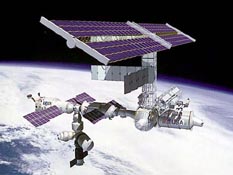 ISS [nasa] |
As with all satellites in orbit above Earth, gravity slowly pulls the space station downward from orbit. It sinks at a rate of several hundred yards a day or about 1.5 miles a week. To keep it up there in space, docked shuttles have pushed it higher to its original altitude. A Progress cargo freighter also can boost the station up to its optimal orbit.
In fact, the engines of the unmanned Progress M-47 cargo freighter docked at the station were used Feb. 11 to boost the ISS to a higher altitude appropriate for the arrival of the Soyuz taxi flight in April.
Starting at 6:34 a.m. EST that day, the Progress engines were ordered to fire for 22 minutes. That raised the station altitude by about 5.7 miles. Currently, the ISS is an orbit ranging from 240 to 255 miles above Earth.
Past delays. The shuttle fleet has been stuck on the ground for long periods before. The longest was 32 months from 1986-1988 during the investigation after Challenger. More recently, flights were stopped for three months in 2002 when tiny cracks were spotted in the fuel lines of all four shuttles — Columbia, Discovery, Atlantis and Endeavour.
Shuttles have been the construction vehicles for the space station. Its core components had been scheduled to be completed in 2004. Then the rest of the ISS construction had been expected to be completed with the station fully operational by 2008 to 2010. That will be delayed as shuttle flights are held up.
So, what now? The space shuttle fleet won't fly again until Fall 2004 at the earliest. In the interim, three-seat Russian Soyuz capsules will be used to ferry people to and from the station. There's always at least one Soyuz docked at the station in case its service is needed as an escape vehicle.
The Expedition 6 crew — Ken Bowersox, Don Pettit, Nikolai Budarin — had been in space from November 23, 2002. They returned to Earth on May 4, 2003, in the Soyuz TMA-1 capsule docked at the station.
Expedition 7. In turn, they were replaced by Russian cosmonaut and commander Yuri Malenchenko, 41, and American astronaut and science officer Ed Lu, 39, who had been trained to be part of a three-member Expedition 7 crew. Malenchenko and Lu flew up to the station in a fresh Soyuz — TMA-2 — that remained docked with the station as their lifeboat during their six-month ISS tour to October 2003.
They were the first two-person ISS crew and the first primary crew to travel to the space station on a Russian Soyuz spacecraft. They docked their Soyuz TMA-2 capsule with the space station some 250 miles over Kazakhstan, a former Soviet Union republic in central Asia. Their Soyuz TMA-2 capsule had been launched from Russia's Baikonur Cosmodrome in Kazakhstan on April 26.
Both men had prior space station experience. Malenchenko had commanded a four-month tour aboard Russia's Mir space station in 1994. Lu had flown to Mir in 1997. Malenchenko and Lu previously had visited the International Space Station in August 2000. During that trip they had taken a spacewalk for more than six hours to hook up cables along the outer walls of the then-unoccupied station.
Station maintenance is the main assignment during their six-month visit in 2003. Lu and Malenchenko also conducted tests on preventing bone loss in the low-gravity environment and other biological experiments.
By reducing the crew from three to two, ISS supplies would last longer. The shuttle's fuel cells produce water as a by-product in generating electricity.
The reduced crews will maintain systems aboard the station, make repairs as needed, and carry on the science experiments until the shuttle fleet resumes flights. If a spacewalk — an extravehicular activity or EVA — were to become necessary, the two crew members would go outside together.
Shuttles still weren't flying at the end of Expedition 7's time in space in October 2003, so Malenchenko and Lu used their Soyuz-TMA capsule to return to Earth. In turn, they were replaced by an Expedition 8 crew composed of American astronaut and commander Michael Foale and Russian cosmonaut and flight engineer Alexander Kaleri who flew a fresh Soyuz up to the station on October 18, 2003.
Expedition 8. The International Space Station (ISS) Expedition 8 crew composed of American astronaut and commander Michael Foale and Russian cosmonaut and flight engineer Alexander Kaleri flew Soyuz TMA-3 up to the station on October 18, 2003.
They replaced the Expedition 7 crew, Russian cosmonaut and commander Yuri Malenchenko and American astronaut and science officer Ed Lu.
Michael Foale had been aboard Russia's former Mir station in June 1997 when it was struck by a runaway Progress cargo freighter. At the time of the Columbia tragedy, he was training to be commander of the Expedition 8 crew. Kaleri was to have been the third member of the Expedition 7 crew.
Crews train on Soyuz systems at Russia's Star City cosmonaut training center. Russia has accelerated construction of two additional Progress cargo freighters so there can be four deliveries of food, water, fuel and supplies in 2003 and five in 2004.
STS-114. NASA announced on April 26, 2003, that the crew of the next shuttle mission, flight STS-114, would include commander Eileen Collins, pilot James Kelly and mission specialists Stephen Robinson and Soichi Noguchi of NASDA, the Japanese space agency.
The shuttle crew would be accompanied by three astronauts and cosmonauts who would replace the ISS crew.
The date for that flight has not been set, as NASA works to improve the fleet following the recommendations of the STS-107 accident investigation panel. The space agency hopes to launch STS-114 in the fourth quarter of 2004.
- The flight will be the first for Soichi Noguchi, who will be the second Japanese astronaut to visit the ISS. Previously, Koichi Wakata had flown aboard STS-92 in 2000,
- Eileen Collins already has flown three shuttle missions, once before as commander. She flew missions STS-63 in 1995, STS-84 in 1997, and STS-93 in 1999 when Columbia ferried the Chandra X-Ray Observatory to orbit. On STS-93, Collins was the first woman Shuttle Commander,
- James Kelly was pilot of STS-102 in 2001,
- Dr. Stephen Robinson flew on STS-85 in 1997 and STS-95 in 1998. He worked in space with John Glenn during STS-95.
Duque had been scheduled to fly up to the ISS with the expedition 7 crew. Instead, he flew in the third seat of the replacement Soyuz that took the Expedition 8 crew to the ISS on October 18, 2003. After a week, he would fly back down with the Expedition 7 crew.
Kuipers will follow the same rotation six months later, flying up with the Expedition 9 crew in April 2004, and returning to Earth after a week with the departing Expedition 8 crew.
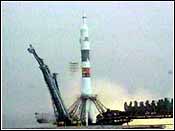 Soyuz launch [ap] |
Shuttle Compared With Soyuz.
top of this page
A Russian space capsule type known as Vostok carried the first human, Yuri Gagarin, from Earth to orbit in 1961. Later, an improved Vostok called Voskhod carried humans to orbit. Meanwhile, the Soviet Union was developing a new capsule for manned Moon flight. It was called Soyuz, which means Union in Russian.
An unmanned Soyuz test blasted off in 1966. Then the first manned Soyuz capsule flight carried a human to space in April 1967. That capsule, referred to as Soyuz-1, was supposed to rendezvous with an unmanned capsule called Soyuz-2. Unfortunately, problems inside Soyuz-1 caused the USSR to cancel Soyuz-2. Then, during re-entry, its landing parachute failed and Soyuz-1 crashed into the ground. That killed cosmonaut Vladimir Komarov, setting back the Russian lunar program.
Since then, however, more than 220 have been built and have flown with more than 100 cosmonauts on a variety of missions. Today, Soyuz is the longest serving manned spacecraft in the world.
Over the decades, numerous modifications have refined the original capsule design to improve its capabilities as a transport vehicle, upgrade its electronic and navigation systems, and eventually allow it to dock with various space stations.
Soyuz history more Soyuz history even more Soyuz history Soyuz program history Soyuz flight history
Over the decades, Soyuz has built up a strong safety record. Its last fatal flight was in 1971 when three cosmonauts died during re-entry.
A Soyuz capsule can carry three people. Progress capsules are Soyuz capsules modified to haul freight to space. They fly unmanned and can carry about 2.5 tons of supplies. By comparison, a shuttle can carry seven people and 25 tons of cargo.
Typically in the past, U.S. shuttles have ferried long-term crews to the station, while Soyuz transports have carried short-term visiting astronauts, cosmonauts and tourists to the ISS.
Soyuz and Progress capsules are not reusable. Shuttles are reusable, and they take less time to get to the ISS at less cost than a Soyuz or Progress.
It takes two years to build and launch a Soyuz transport, slightly less to build a Progress cargo ship. It could take up to four years to build a new shuttle, if the old patterns still were available. However, it seems highly unlikely that a replacement shuttle in the style of the three remaining orbiters will be built.
Replacing the Shuttles.
top of this page
NASA's next-generation Orbital Space Plane probably won't fly until 2010. In the meantime, the three remaining shuttles, plus Soyuz and Progress capsules, can carry astronauts and supplies to the ISS.
Europe's ATV. In addition, the European Space Agency is finishing development of its new Automated Transfer Vehicle designed to carry supplies to the station. The first ATV trip to the ISS is planned for the end of 2004.
Most communications, military and science satellites won't be affected as they are launched on expendable single-use rockets.
The International Space Station is a joint project of the United States, Japan, the European Union and Canada. Japan is the second-largest contributor after the United States, paying about one-fifth of the cost.
 Challenger Seven [nasa] |
Recalling the Challenger Disaster.
top of this page
The Columbia disaster reminded Americans of the explosion of shuttle Challenger during liftoff 17 years earlier. Seven crew members, including New Hampshire schoolteacher Christa McAuliffe, had been killed as Challenger blasted upward from Kennedy Space Center on Jan. 28, 1986.
Challenger disintegrated in the sky just 73 seconds into its flight. The Challenger explosion was blamed on a gas leak in the right booster rocket. The crew module separated from the fireball and dropped on a 2.5-minute free fall from 50,000 feet into the sea. The crew had no parachutes and there was no way to jettison the hatch. The crew died as Challenger disintegrated in flames while millions watched live television.
Flying in the shuttle with Christa McAuliffe were commander Francis R. "Dick" Scobee, pilot Michael J. Smith, mission specialists Judith A. Resnik, Ronald E. McNair and Ellison S. Onizuka, and payload specialist Gregory B. Jarvis, an employee of Hughes Aircraft Corp. Christa McAuliffe had been chosen in 1984 from 11,000 teachers who had applied to fly on the Challenger mission.
After Challenger, the shuttle program was on hold for almost three years to 1988.
More about Challenger Even more about Challenger
top of this page
Learn more:
- Space Shuttle Columbia NASA
- Space Research and You – An Overview of STS-107 pdf
- STS-107 Mission Patch NASA
- Columbia OV-102 Background Kennedy Space Center
- NASA Space Shuttles NASA Human Spaceflight
- Past and Future Flights Kennedy Space Center
- Space Shuttle Reference Manual Kennedy Space Center
- Liftoff To Space Exploration Marshall Space Flight Center
- NASA – the U.S. space agency NASA Headquarters
- NASA History of Challenger NASA History Office
- Man-in-Space Firsts Hundreds of extraordinarily-interesting stories at Space Today Online
- Space Factoids Lost tidbits recovered and misplaced stories recalled at Space Today Online
- The Millennium Space and Astronomy Timeline at Space Today Online
